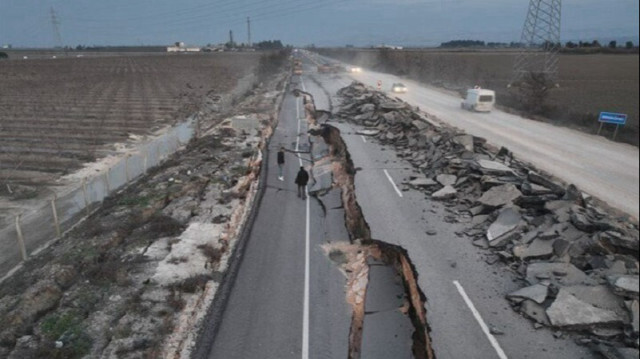
Twin quakes Türkiye suffered were as destructive as largest nuclear test ever carried out, American professor tells Anadolu
Last week’s twin earthquakes in Türkiye are comparable to the world's largest nuclear test, Jackie Caplan-Auerbach, a professor of geology at Western Washington University, told Anadolu on Tuesday.
In an evaluation of the magnitude and characteristics of the quakes, whose epicenters were southern Kahramanmaraş province’s Pazarcık and Elbistan districts, Caplan-Auerbach said the earthquakes were “a truly tragic event.”
“It's a somewhat unusual event in that this portion of southern Türkiye, although it does get earthquakes, has not seen an earthquake of this size in quite some time. That said, it's a very seismically active area. It's just that the timescales over which the Earth generates earthquakes and the timescales where we experienced them are somewhat different,” she added.
Emphasizing that the region is seismically active and there have been major earthquakes over time, Caplan-Auerbach said the growth of the population over time led to more casualties after such quakes.
She also underlined that the quakes happened at a depth that is very close to the surface, making the tragedy even worse.
“And that enhances the ground shaking, causing it to be a more violent experience,” she added.
- 'Uncommon but not unheard of'
Regarding the two devastating earthquakes in Kahramanmaraş, Caplan-Auerbach underlined that the quakes were “certainly uncommon, but not unheard of.”
“Sometimes motion on one fault will increase the stress on another and push it into failure. Whether that's what happened here, whether this is a traditional aftershock is harder to evaluate at this early stage," she added.
Caplan-Auerbach further stated that according to the current assessments, an earthquake on one fault line triggered another fault line.
“This is a huge aftershock. But again, this is not unheard of,” she said, referring to the magnitude 7.6 earthquake that took place later.
Reminding that another magnitude 7 earthquake struck a few days after a 6.5 magnitude quake in California a few years ago, Caplan-Auerbach said: "And then several days later, it had another one that was a little larger. That was a seven and change. So we do see them, but as you've said, they're less common," she said.
- 'We cannot say exactly what will happen in the future'
Pointing out that the earthquake was very close to the surface and in a wide area, Caplan-Auerbach said "it is very difficult to predict what will happen next in earthquakes.”
“They are very random events. They occur without warning. So our hope is that this area has released some of the stress, but it may have added stress to other portions, so we really cannot say what the future will hold.”
With regards to the magnitude, she said “this earthquake was a very, very big earthquake.”
“This was a very large earthquake. This was a magnitude 7.8. It's probably comparable with the largest nuclear test ever run -- not a bomb that hit anybody, but the largest bombs that we have tested. Obviously, a very different event in that it stretches across a very long area. The larger the earthquake, (and) typically, the larger the fault, the larger the area that moves,” she said.
“This fault line spans an area of more than 300 kilometers (186 miles). That's why it affected so many people,” she said.
In this case, that really meant it stretched across 300 kilometers or more, which is why it impacted so many communities. Earthquakes come and go, of course, a wide range of sizes, and the scale is enormous. It's a logarithmic scale, which means the 7.8 was probably twice as large as this, as the 7.5,” she added.
"We do see large earthquakes in the world…(But a) shallow (one) beneath the continent is somewhat unusual. It's sort of one of the largest ones that we have seen."
- 'Need to improve our building codes'
Caplan-Auerbach said that major earthquakes usually take place on ocean coasts where tectonic plates go under another plate.
"So for example, the 2011 Japan earthquake in Tohoku and the earthquake that hit Sumatra in 2004 were considerably larger but a little more distant from the communities they impacted."
"I think maybe the thing we see most clearly is the need to always improve our building codes, because the great tragedy has been the collapse of buildings. Older buildings are often not constructed to the levels that we know now,” she said.
"We always hope that we will all learn, but really the only other thing I will add is my deepest sympathies to the people of Türkiye and the people of Syria who are impacted by this. Please know that the whole world is standing with you and experiencing your grief with you," she added.
On Feb. 6, two massive earthquakes struck southern Türkiye.
The magnitude 7.7 and 7.6 tremors were centered in Kahramanmaraş and hit nine other provinces – Hatay, Gaziantep, Adiyaman, Malatya, Adana, Diyarbakir, Kilis, Osmaniye and Sanliurfa.
They also affected several other countries and caused widespread destruction in northern Syria.
At least 35,418 people were killed in Türkiye, according to the latest official figures, while the death toll topped 3,600 in Syria.
Hello, the comments you share on our site are a valuable resource for other users. Please respect other users and different opinions. Do not use rude, offensive, derogatory, or discriminatory language.
The floor is all yours.








